This week’s Weekly includes my review of the exhibits by Douglas Takeshi Wolfe and Robbert Flick at Gallery 339. There’s no sketches today. But there’s an editors’ choice listings box with a quick review of the “Very Early Pictures” exhibit at Arcadia University Art Gallery. Here’s the link to the review and here’s the link to the listings box. And below are is the copy with some pictures. For more on Wolfe and Flick see my previous post.
Lens Crafters
One photographer zooms in on the small; the other shrinks the monumental.
Between the photographs of Douglas Takeshi Wolfe and Robbert Flick at Gallery 339 is a brotherliness you might find between likeminded souls. Which isn’t to say that the artists-one local (Wolfe), the other from Los Angeles (Flick)-are doing similar work.
While they both depict urban or rural landscapes that suggest the big eternal picture and the passage of time, Wolfe is looking through the small end of the telescope making the infinitesimal monumental. Flick, especially with his later works, is a “big ender” whose sliced and diced panoramas aggregate many small moments and turn them into a monumental river of life.
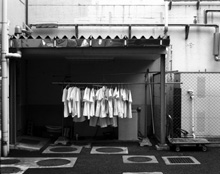
Wolfe’s exhibit “31” in the upstairs gallery covers work from the last 10 years. Shot in Philadelphia, Seattle, Italy and Japan, the black-and-white images-available in a catalog self-produced by the artist-range from a street scene with one lone graffiti arabesque to shots of birds on electrical wires, paint peeling on a wall, and some images of brooding dark office buildings. Without including a body or face in the lot, the works imply the human experience of being alone in a timeless universe.
What separates Wolfe from modern masters like Harry Callahan or Ray Metzger who also depict small moments as monumental is Wolfe’s sense of wonder, which swings from exuberant to questioning. While some of Wolfe’s shots brood-like Itabashikuyakiushomae, Tokyo, a line of white shirts on hangers in a dark laundry space-others evoke something like glee.
(image above is Wolfe‘s Itabashikuyakiushomae, Tokyo)
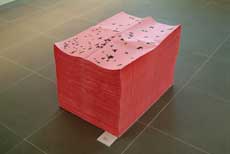
Birds on wires either alone or perched together in long lines are coffee-klatching friends gathered in networking strings like IM chat buddies. Birds in flight-depicted in four images in the exhibit-convey not only wonder but a big-hug embrace of nature and the cosmos.
Wolfe’s Ephemera is a bird-in-flight photo that is reproduced as a freebie poster in an “infinite” stack sitting on the gallery’s floor. It’s a joyous image-and a generous impulse to give it away. Ephemera asks you to reflect on the fragility of life in the larger scheme of things but reminds you to have a little fun while you’re at it. (image is Wolfe‘s infinite stack “Ephemera.”)
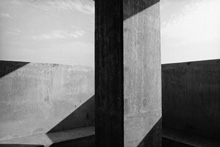
Robbert Flick’s images have less joy but are imbued with the artist’s poetic view of the world. The Los Angeles-based photographer, recently featured in a retrospective at the L.A. County Museum of Art, has works from three series here: black-and-white shots of a parking ramp from the ’70s that are beautiful depictions of light and shadow and structure as hard-edged geometry; gridded sequences of black-and-white landscape imagery that read as stories about site; and Los Angeles Documents, more sequences, taken with a video camera from a moving car, then printed as horizontal streams and collaged into fabric-like swatches of imagery.
(image above is from Flick‘s parking ramp series and below is one of his LA Documents pieces)
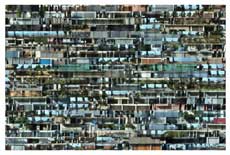
The L.A. Documents, in color, have a horizontal matrix-like flow. More than the earlier works, these L.A. street scenes imply the chaos and serendipity of the universe. Like life itself, they need to be studied up close and viewed from afar to be understood.
“Douglas Takeshi Wolfe: 31” and “Robbert Flick: Sequential Views”
Through Oct. 23. Gallery 339, 339 S. 21st St. 215.731.1530.
“Very Early Pictures”
Through Oct. 30. Arcadia University Art Gallery, 450 S. Easton Rd., Glenside. 215.572.2133.
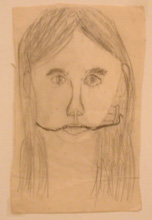
“Very Early Pictures” at Arcadia is every mother’s nightmare–a group exhibit of children’s art that probably doesn’t include her child. But if the mother-jealousy factor
doesn’t bother you, I guarantee you’ll find things to love in this exhibit, which is, after all, art by 60 gifted children who continue to make art now as adults–some of them as international superstars. Hindsight is not a valid lens through which to read this exhibit, looking back for signs of genius, but it’s the natural tendency. For what it’s worth, graphic novelist Charles Burns seems to have been born a cartoonist; and stained glass artist of pain and sorrow Judith Schaechter shows acute empathy for human suffering in a drawing at age 3.
(image is Schaechter‘s self-portrait in dental headgear when she was 14 or so. It was one of my favorites in the show.)
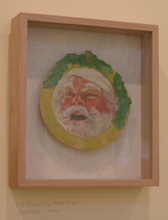
And while “VEP” isn’t an exhibit to demonstrate some point about child development or art education, there’s one outstanding example of bad school art: Ed Ruscha’s magazine cut-out Santa circled by a generic construction paper wreath. The piece’s awfulness is redeemed by the fact that in another context it would be deemed conceptual and postmodern, and you might even call it a typical Ed Ruscha. Ultimately “VEP” is a celebration of every mother’s child making art–and of every mother who’s saving it, and that’s sweet.
(last image is Ruscha‘s school boy Santa)









